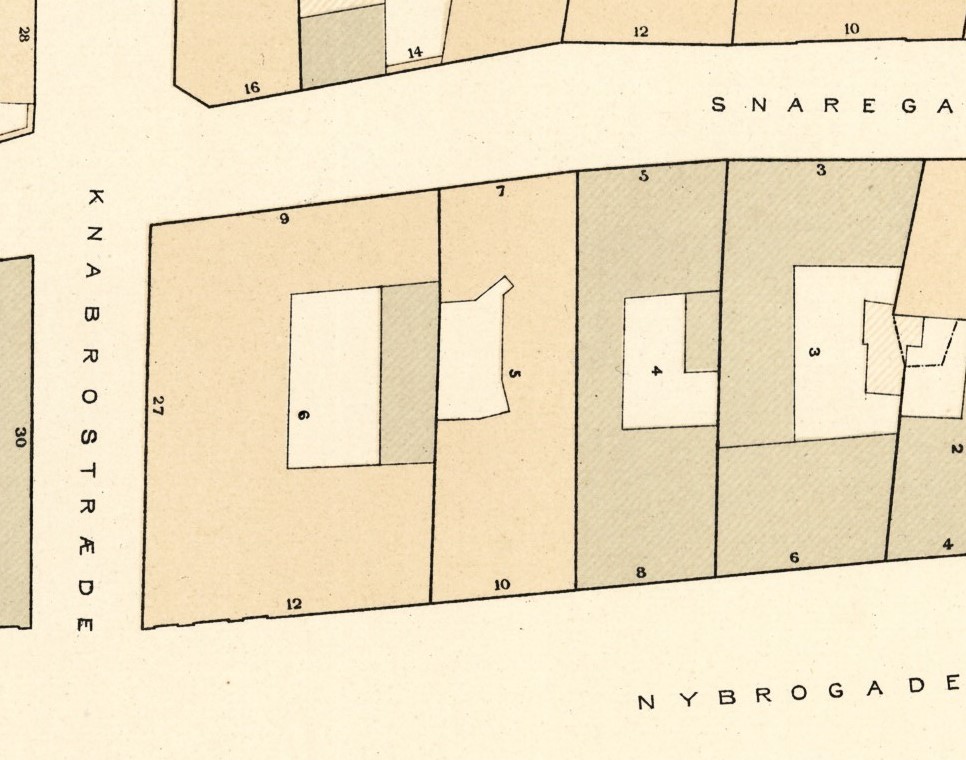|
Ziegler House, Copenhagen
The Ziegler House (Danish: (Hofkonditor) Zieglers Gård), located at the corner of Nybrogade (No. 12) and Knabrostræde (No. 27), is an 18th-century Rococo-style, bourgeoisie townhouse overlooking Slotsholmens Kanal and Slotsholmen in central Copenhagen, Denmark. The building was designed by Philip de Lange and formerly also known as Eneretsgården. It is now owned by Karberghus and operated as serviced offices under the name Zieglers Gaard Office Club. It was listed on the Danish registry of protected buildings and places in 1918. History 18th century The site was formerly made up of two separate properties. The eastern of these properties were listed in Copenhagen's first cadastre of 1689 as No. 7 in Snaren's Quarter, owned by councilman Morten Nielsen. The owestern property was listed as No. 8 and belonged to and recently deceased Thomas Engelbreht's heirs. The buildings were both destroyed in the Copenhagen Fire of 1728. Court pastry chef Johan Henrik Ziegler charged Phi ... [...More Info...] [...Related Items...] OR: [Wikipedia] [Google] [Baidu] |
Rococo
Rococo (, also ), less commonly Roccoco or Late Baroque, is an exceptionally ornamental and theatrical style of architecture, art and decoration which combines asymmetry, scrolling curves, gilding, white and pastel colours, sculpted moulding, and ''trompe-l'œil'' frescoes to create surprise and the illusion of motion and drama. It is often described as the final expression of the Baroque movement. The Rococo style began in France in the 1730s as a reaction against the more formal and geometric Louis XIV style. It was known as the "style Rocaille", or "Rocaille style". It soon spread to other parts of Europe, particularly northern Italy, Austria, southern Germany, Central Europe and Russia. It also came to influence the other arts, particularly sculpture, furniture, silverware, glassware, painting, music, and theatre. Although originally a secular style primarily used for interiors of private residences, the Rococo had a spiritual aspect to it which led to its widespread use in ... [...More Info...] [...Related Items...] OR: [Wikipedia] [Google] [Baidu] |
Dronningens Tværgade
Dronningens Tværgade ( lit. "The Queen's Cross Street") is a street in central Copenhagen, Denmark, which runs from Bredgade to Rosenborg Castle Garden. The street originally formed a link between the King's Garden (Rosenborg Castle Gardens) and the Queen's Garden. With the Odd Fellows Mansion on Bredgade and the central pavilions of the east fringe of the castle garden located at each their end, the street has axial qualities. These are accentuated by the Dronningegården Estate, a Functionalist housing complex from the 1940s, which forms an urban space around the intersection with Adelgade. History Dronningens Tværgade originates in the 1649 plan for New Copenhagen, the large area which was included in the fortified city when the old East Rampart along present day Gothersgade was decommissioned and a new one was built in a more northerly direction. According to the plan, the streets in the area were to be named after Danish territorial possessions, royalty and the upper ... [...More Info...] [...Related Items...] OR: [Wikipedia] [Google] [Baidu] |
Book Binding
Bookbinding is the process of physically assembling a book of codex format from an ordered stack of ''signatures'', sheets of paper folded together into sections that are bound, along one edge, with a thick needle and strong thread. Cheaper, but less permanent, methods for binding books include loose-leaf rings, individual screw-posts (binding posts), twin loop spine coils, plastic spiral coils, and plastic spine combs. For protection, the bound stack of signatures is wrapped in a flexible cover or is attached to stiffened boards. Finally, an attractive cover is placed onto the boards, which includes the publisher's information, and artistic decorations. The trade of binding books is in two parts; (i) stationery binding (vellum binding) for books intended for handwritten entries, such as accounting ledgers, business journals, blank-page books, and guest logbooks, and notebooks, manifold books, day books, diaries, and portfolios. (ii) letterpress printing and binding deals with ... [...More Info...] [...Related Items...] OR: [Wikipedia] [Google] [Baidu] |
Gabriele Rohde
Gabriele Rohde (1904–1946) was a Danish League of Nations official in the 1930s and, during the Second World War, a member of the Danish Council (''Det danske Råd'') in London. She provided strong support in particular for Danish seafarers, creating a seamen's club in Newcastle. In 1943, Rohde travelled to Canada and the United States where she became an advisor to Henrik Kauffmann, the Danish ambassador in Washington. She assisted him in particular with his participation in the United Nations Relief and Rehabilitation Administration (UNRRA) conference which was held in Atlantic City that November. Shortly after returning to Denmark at the end of the war, she died in a tragic accident. Biography Born in Copenhagen on 7 September 1904, Gabriele Rohde was the daughter of the painter Johan Gudmann Rohde (1856–1935) and Asa Zøylner (1874–1960). In May 1945, she married the estate owner and resistance member Gunnar Flemming Juncker (1904–2002). Brought up in a cultural mili ... [...More Info...] [...Related Items...] OR: [Wikipedia] [Google] [Baidu] |
Johan Rohde
Johan Gudmann Rohde (1 November 1856 – 18 February 1935) was a Danish painter, lithographer and designer. He was the principal founder of Den Frie Udstilling, established in 1891 to allow artists to exhibit works which did not fall within the Academy's selection criteria."Om Den Frie" , Den Frie Udstilling. Retrieved 30 January 2013. Early life Rhode was born on 1 November 1856 in , the son of merchant Hermann Peter Rohde. (1827–97) and Ane Marie Schmidt (1832–1915). He matriculated from grammar school in 1875, he first studied medicine before deciding to turn to art and paintings. After studying privately under Wenzel Tornøe, he entered the Academy in 1882. Unhappy with the institution's refusa ...[...More Info...] [...Related Items...] OR: [Wikipedia] [Google] [Baidu] |




